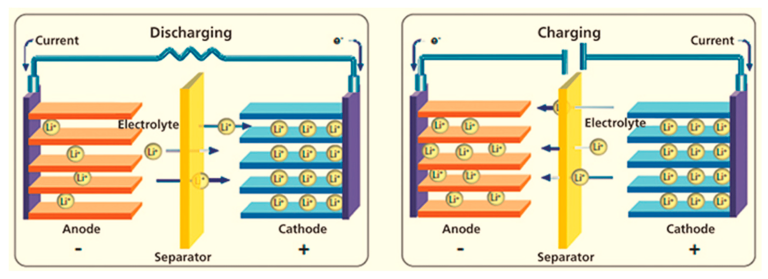Introduction
Lithium-ion batteries have become the cornerstone of modern energy storage, powering everything from smartphones and laptops to electric vehicles and renewable energy systems. Central to the performance and safety of these batteries is the electrolyte—a medium that facilitates the movement of lithium ions between the anode and cathode during charge and discharge cycles. As the demand for higher performance, safer, and more efficient batteries grows, advancements in lithium-ion battery electrolytes are critical. This article explores the characteristics, types, challenges, and future directions of advanced lithium-ion battery electrolytes.

Characteristics of Lithium-Ion Battery Electrolytes
Ionic Conductivity
A key characteristic of a good electrolyte is high ionic conductivity. This ensures that lithium ions can move swiftly and efficiently between the electrodes, which is essential for high power and energy density. Ionic conductivity is influenced by the composition of the electrolyte and its temperature stability.
Electrochemical Stability
The electrolyte must be stable within the voltage range of the battery’s operation. It should not decompose at high voltages, which can otherwise lead to capacity loss, reduced battery life, and potential safety hazards. Electrochemical stability is crucial for maintaining battery performance and longevity.
Thermal Stability
In addition to electrochemical stability, thermal stability is important to prevent the electrolyte from breaking down at elevated temperatures. This characteristic is particularly critical in applications like electric vehicles, where batteries can experience significant temperature fluctuations.
Safety
Safety is a paramount concern in lithium-ion batteries. Advanced electrolytes are designed to minimize risks such as thermal runaway, where overheating can lead to fires or explosions. Non-flammable and thermally stable electrolytes are key areas of research to enhance battery safety.
Types of Advanced Lithium-Ion Battery Electrolytes
Liquid Electrolytes
Traditional liquid electrolytes typically consist of lithium salts dissolved in organic solvents. While they offer good ionic conductivity, they can pose safety risks due to their flammability and potential for leakage.
- High-Voltage Electrolytes: These are designed to be stable at higher voltages, which can enhance the energy density of lithium-ion batteries. They often incorporate additives that form protective films on the electrodes, preventing decomposition.
- Non-Flammable Electrolytes: Innovations in liquid electrolytes include the development of non-flammable formulations. These electrolytes use solvents with high flash points or additives that suppress flammability.
Solid Electrolytes
Solid electrolytes represent a significant advancement in lithium-ion battery technology. They promise enhanced safety and stability over their liquid counterparts.
- Solid Polymer Electrolytes (SPEs): These are composed of polymers that facilitate ion transport. SPEs are flexible and can be processed into thin films, but they generally have lower ionic conductivity compared to liquid electrolytes.
- Inorganic Solid Electrolytes: These materials, such as ceramics, offer high ionic conductivity and excellent thermal stability. They are, however, brittle and challenging to manufacture at scale.
- Composite Electrolytes: Combining polymers with inorganic materials, composite electrolytes aim to leverage the advantages of both types, offering improved ionic conductivity and mechanical stability.
Gel Electrolytes
Gel electrolytes are a hybrid between liquid and solid electrolytes, combining the ionic conductivity of liquids with the mechanical stability of solids.
- Polymer Gel Electrolytes: These consist of a polymer matrix swollen with liquid electrolyte, providing a safer and more stable alternative to pure liquid electrolytes while maintaining good ionic conductivity.
Challenges in Developing Advanced Electrolytes
Balancing Conductivity and Stability
One of the primary challenges in developing advanced electrolytes is balancing ionic conductivity with electrochemical and thermal stability. High ionic conductivity is essential for battery performance, but it must not come at the expense of stability.
Interface Compatibility
Ensuring compatibility between the electrolyte and the electrodes is critical. Poor interface compatibility can lead to the formation of resistive layers, reducing battery efficiency and lifespan. Advanced electrolytes must form stable and low-resistance interfaces with both the anode and cathode.
Manufacturing and Scalability
Producing advanced electrolytes at scale remains a significant challenge. Solid and composite electrolytes, in particular, require complex manufacturing processes that need to be refined for large-scale production.
Cost
The cost of advanced electrolytes can be prohibitive, especially for high-performance applications like electric vehicles. Developing cost-effective materials and manufacturing processes is essential to make these advanced technologies viable in the market.
Future Directions in Lithium-Ion Battery Electrolytes
Next-Generation Solid Electrolytes
Research is ongoing to develop next-generation solid electrolytes with improved ionic conductivity and mechanical properties. Innovations in materials science, such as the use of novel ceramics and polymers, are key areas of focus.
Advanced Additives
The use of advanced additives in liquid and gel electrolytes can significantly enhance their performance and safety. These additives can improve ionic conductivity, stabilize the electrolyte at high voltages, and reduce flammability.
Hybrid Electrolytes
Hybrid electrolytes that combine the best features of liquid, solid, and gel electrolytes are an exciting area of research. These materials aim to offer high ionic conductivity, excellent stability, and enhanced safety.
Electrolyte-Electrode Integration
Improving the integration of electrolytes with electrodes is crucial for advancing lithium-ion battery technology. Techniques to enhance interface stability and reduce resistance at the electrolyte-electrode boundary are critical for optimizing battery performance.
Conclusion
Advancements in lithium-ion battery electrolytes are pivotal to meeting the growing demand for high-performance, safe, and efficient energy storage solutions. From high-voltage liquid electrolytes to innovative solid and gel electrolytes, ongoing research is unlocking new possibilities in battery technology. By addressing challenges related to conductivity, stability, interface compatibility, manufacturing, and cost, the next generation of lithium-ion batteries will be better equipped to power the future of electric vehicles, renewable energy systems, and portable electronics. The continued exploration and development of advanced electrolytes will play a central role in the evolution of energy storage technology, driving progress towards more sustainable and reliable power sources.

